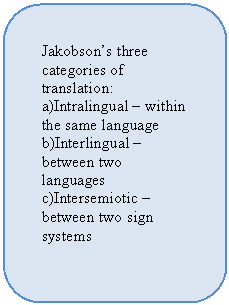| |
Introduction
We have looked at various aspects of translation and now let us look at the different types of translation practice. The most popular categorization in Translation Studies is perhaps Roman Jakobson’s. Roman Jakobson divided translation into three categories, namely intralingual, interlingual and intersemiotic. Although translation theory has travelled a long way since Jakobson, these categories still remain handy and useful. Of these categories, what is popularly understood as translation is interlingual, or the act of translation from one language to another. Intralingual translation or translation that occurs within a particular language system, was not thought of as ‘proper’ translation. At best, it was conceived to be rewriting or paraphrase. As Mona Baker points out in her introduction to th Routledge Encyclopedia of Translation Studies, “One of the most fascinating things about exploring the history of translation is that it reveals how narrow and restrictive we have been in defining our object of study, even with the most flexible of definitions” (xvii). As she observes, despite the Jakobsonian categorization, not much attention has been paid to intralingual or intersemiotic translations, even by translation theorists. types of translation practice. The most popular categorization in Translation Studies is perhaps Roman Jakobson’s. Roman Jakobson divided translation into three categories, namely intralingual, interlingual and intersemiotic. Although translation theory has travelled a long way since Jakobson, these categories still remain handy and useful. Of these categories, what is popularly understood as translation is interlingual, or the act of translation from one language to another. Intralingual translation or translation that occurs within a particular language system, was not thought of as ‘proper’ translation. At best, it was conceived to be rewriting or paraphrase. As Mona Baker points out in her introduction to th Routledge Encyclopedia of Translation Studies, “One of the most fascinating things about exploring the history of translation is that it reveals how narrow and restrictive we have been in defining our object of study, even with the most flexible of definitions” (xvii). As she observes, despite the Jakobsonian categorization, not much attention has been paid to intralingual or intersemiotic translations, even by translation theorists.
Intersemiotic translations, or transference from one form to another, like novel to film, have also been very rarely studied by translation theorists. Baker argues that these are not subsidiary categories of translation, as is the popular perception. She cites the case of African interpreters who could translate the language of drums – those of you who are familiar with the comic strip of “Phantom: the Ghost who Walks” would remember the tribal drums that carried messages regarding intruders into the protected forests of the Phantom. That was intersemiotic translation at work. Baker also points out that most of the translation in the Greek language was intralingual rather than interlingual, for the major work was that of modernizing ancient Greek texts. In most of the ancient Sanskrit plays, there were at least three dialectical versions of pure Sanskrit in use, which required the viewer to translate as she watched the play. This was intralingual translation rather than interlingual.
|